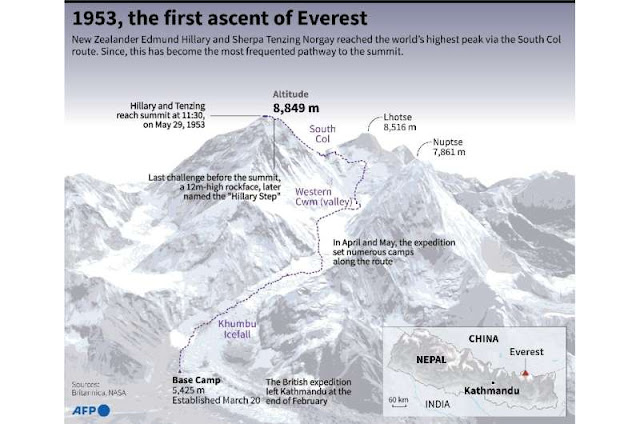Edmund Hillary of New Zealand and Tenzing Norgay Sherpa of Nepal reached the peak of Everest for the first time on May 29, 1953, marking 70 years since their historic achievement. Because of the British mission, the two men became famous all over the world. Overcrowding and pollution have become growing problems as hundreds of people attempt to summit the 8,849-meter (29,032-foot) peak each year. AFP examines how the Everest phenomenon has developed over time.
What is the mountain called?
British cartographers only knew the mountain as Peak XV until it was determined to be the highest point in the world in the 1850s, at which time it was renamed after the previous Surveyor General of India, Sir George Everest.
Sagarmatha means “peak of the sky” in Nepali, and Chomolungma or Qomolangma means “goddess mother of the world” in Sherpa and Tibetan.
How has climbing Everest changed?
It took 20 years and nine expeditions for the first 600 persons to reach the peak. Now, in a single climbing season, many people can be supported by professional guides and expedition outfitters.
In 1964, the town of Lukla, the region’s entrance, built a small mountain airstrip, shortening the months-long journey to the base camp to eight days. Expeditions are now safer since gear is lighter, oxygen is more easily accessible, and tracking devices are used. In the event of an emergency, climbers can now call for a helicopter.
Season after season, intrepid mountaineers can pay expert Nepali guides to lead them to the peak. Billi Bierling, the curator of the climbing expedition archive Himalayan Database, said that while much has changed, certain aspects have stayed the same. Everything was transported by Sherpas. The essence of an expedition is still the same.
What is base camp like?
Everest Base Camp, the place where climbs actually begin, has evolved from a collection of tents at 5,364 meters (17,598 feet) where climbers lived off of canned meals to a more permanent structure.
Crisp discussions on cumbersome satellite phones have given way to wifi and Instagram posts, while stylish coffee and freshly baked meals are now readily available.
How does the news of a summit travel?
Since the news had to be carried down the mountain to a telegraph station in the town of Namche Bazaar, and then communicated to the British Embassy in Kathmandu, it didn’t make it into newspapers until June 2, the day of Queen Elizabeth’s coronation.
After making his eighth ascent in 2011, British climber Kenton Cool tweeted from the peak using a 3G signal. Typically, walkie-talkies are required gear on expeditions, and summiteers use them to get in touch with their base camp teams, who then quickly update social media. As of 2020, China plans to provide 5G connectivity to the peak of Everest.
What are the effects of climate change?
Crevasses are slowly opening up as the mountain warms, and streams are beginning to appear on previously snow-covered slopes. The Khumbu glacier on Everest is extremely sensitive to even modest atmospheric warming, as evidenced by a 2018 study that found the temperature of shallow ice was already close to the melting point. Glaciologist Duncan Quincey said, “The future of the Khumbu icefall is bleak,” in an interview with AFP. The meltwater on the glaciers’ surfaces is the most noticeable change.
This year, three Nepalese guides were killed when a piece of sliding glacial ice washed them into a deep chasm on the mountain. Climbers are more vocal about this issue, and expedition firms are responding by adopting greener techniques at base camps, such as using solar energy.
What is the impact of social media?
Excited mountaineers share their experiences on Facebook, Instagram, and other social media platforms as they make their way to the summit of Everest.
Sponsors are satisfied, and new donors can see posts with hashtags, so it’s a win-win. That goes for the international climbers as well as the modern Nepali guides who accompany them. Lakpa Dendi Sherpa, who has summited Everest numerous times and has 62,000 Instagram followers, said, “Everyone posts nowadays, it is part of how we share and build our profile.”
Mountain of records?
Both veteran Nepali guides Kami Rita Sherpa and Pasang Dawa Sherpa summited Everest twice this season, with Pasang Dawa tying the record for most summits twice before Kami Rita recaptured the top spot with a total of 28. Multiple categories exist for firsts and fastest on Everest. On the other hand, there are some outlandish examples: in 2018, a group of British climbers, an Australian, and a Nepali dressed up in tuxedos and gowns for a dinner party at 7,056 meters on the Chinese side of the mountain.
